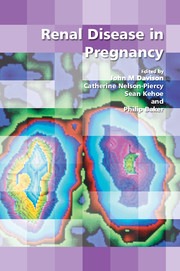Book contents
- Frontmatter
- Contents
- Participants
- Preface
- SECTION 1 RENAL PHYSIOLOGY IN PREGNANCY
- SECTION 2 PATTERNS OF CARE
- SECTION 3 CHRONIC KIDNEY DISEASE
- SECTION 4 DRUGS USED IN RENAL DISEASE IN PREGNANCY
- SECTION 5 ACUTE RENAL IMPAIRMENT
- 14 Acute renal failure in pregnancy: causes not due to pre-eclampsia
- 15 Pre-eclampsia-related renal impairment
- 16 Renal biopsy in pregnancy
- SECTION 6 UROLOGY AND PREGNANCY
- SECTION 7 SURGICAL AND MEDICAL ISSUES SPECIFIC TO RENAL TRANSPLANT PATIENTS
- SECTION 8 CONSENSUS VIEWS
- Index
16 - Renal biopsy in pregnancy
from SECTION 5 - ACUTE RENAL IMPAIRMENT
Published online by Cambridge University Press: 05 September 2014
- Frontmatter
- Contents
- Participants
- Preface
- SECTION 1 RENAL PHYSIOLOGY IN PREGNANCY
- SECTION 2 PATTERNS OF CARE
- SECTION 3 CHRONIC KIDNEY DISEASE
- SECTION 4 DRUGS USED IN RENAL DISEASE IN PREGNANCY
- SECTION 5 ACUTE RENAL IMPAIRMENT
- 14 Acute renal failure in pregnancy: causes not due to pre-eclampsia
- 15 Pre-eclampsia-related renal impairment
- 16 Renal biopsy in pregnancy
- SECTION 6 UROLOGY AND PREGNANCY
- SECTION 7 SURGICAL AND MEDICAL ISSUES SPECIFIC TO RENAL TRANSPLANT PATIENTS
- SECTION 8 CONSENSUS VIEWS
- Index
Summary
Renal biopsy in general nephrological practice
Since its first description in the early 1950s, percutaneous renal biopsy has evolved to become an indispensable tool in the management of patients with kidney disease. In general nephrological practice the most common indications for performing native kidney biopsy are nephrotic syndrome, unexplained urinary dipstick abnormalities, acute kidney injury, renal dysfunction in the setting of systemic immunological diseases such as lupus or vasculitis, unexplained chronic kidney disease and familial renal disease. Ideally, the biopsy should provide specific diagnostic and prognostic information and facilitate informed management decisions. Recent prospective studies show that the pathological diagnosis provided by kidney biopsy results in altered patient management in 50—80% of cases.
In some situations renal biopsy may be unsafe or technically impossible. An uncorrectable bleeding diathesis is an absolute contraindication to percutaneous renal biopsy, whereas hypertension (blood pressure above 160/95 mmHg) or hypotension, urinary infection, low platelet count, single kidney, renal cysts or tumour, severe anaemia, uraemia, obesity and an uncooperative patient are relative contraindications.
In general, renal biopsy is performed with the patient in the prone position using local anaesthesia. Ultrasonography is used to locate the lower pole of the kidney and the biopsy needle advanced to the kidney under direct ultrasound guidance. This may be more challenging in large or obese patients.
- Type
- Chapter
- Information
- Renal Disease in Pregnancy , pp. 201 - 206Publisher: Cambridge University PressPrint publication year: 2008
- 2
- Cited by

